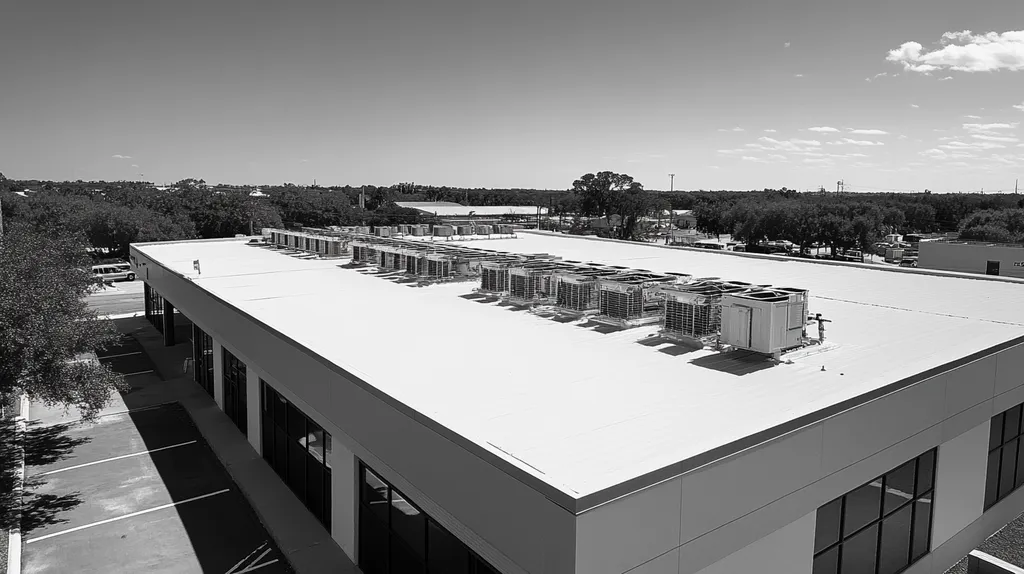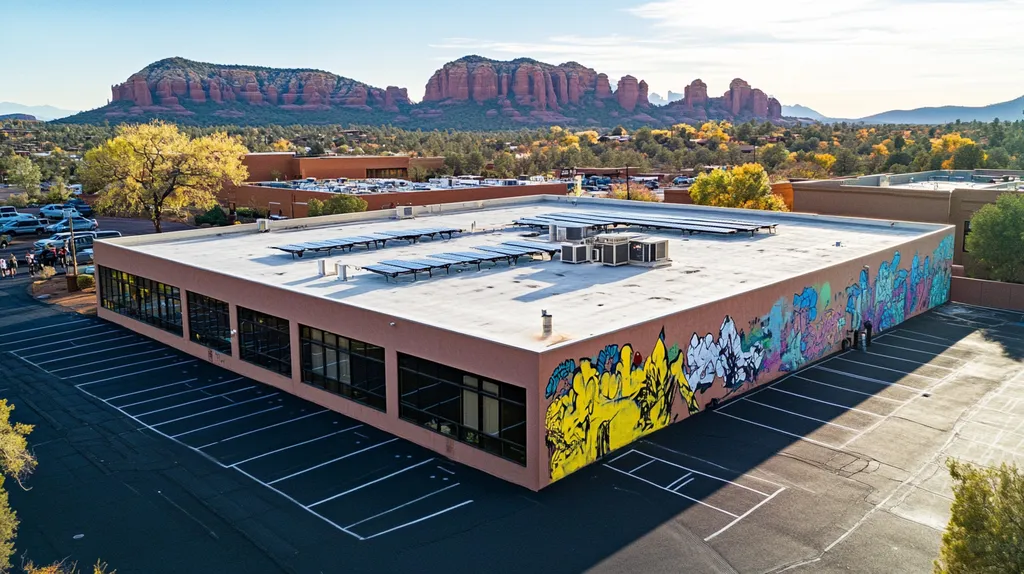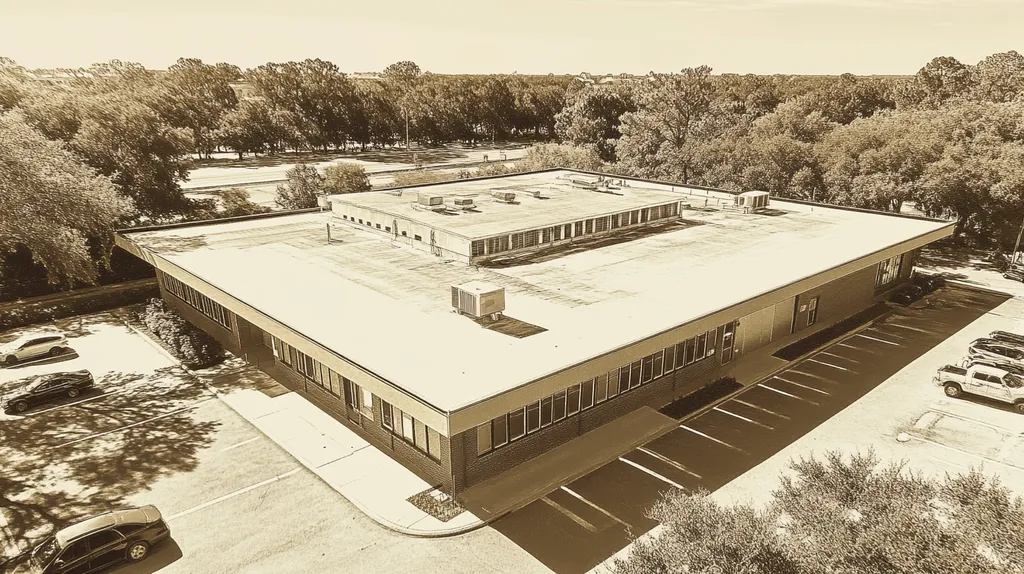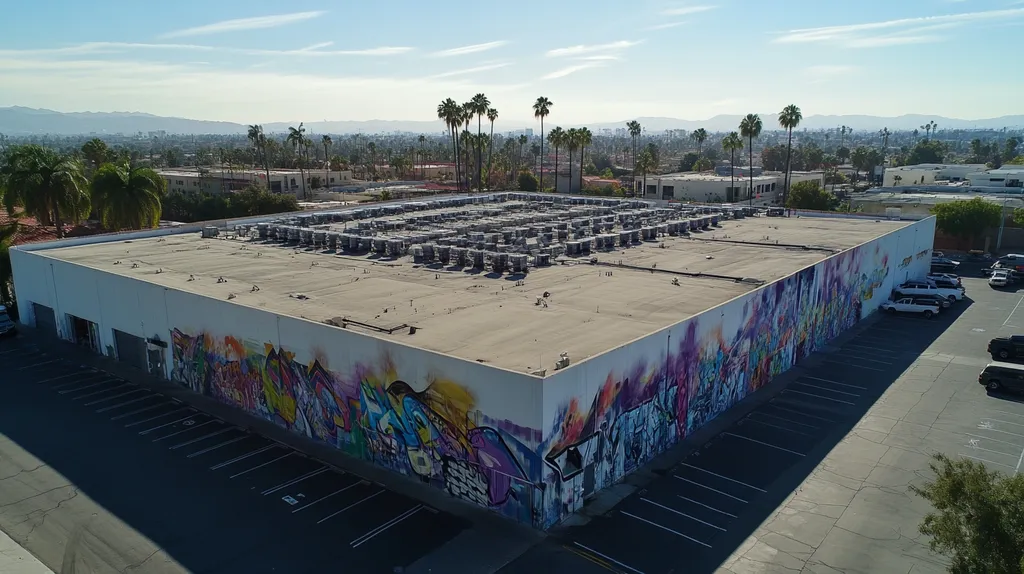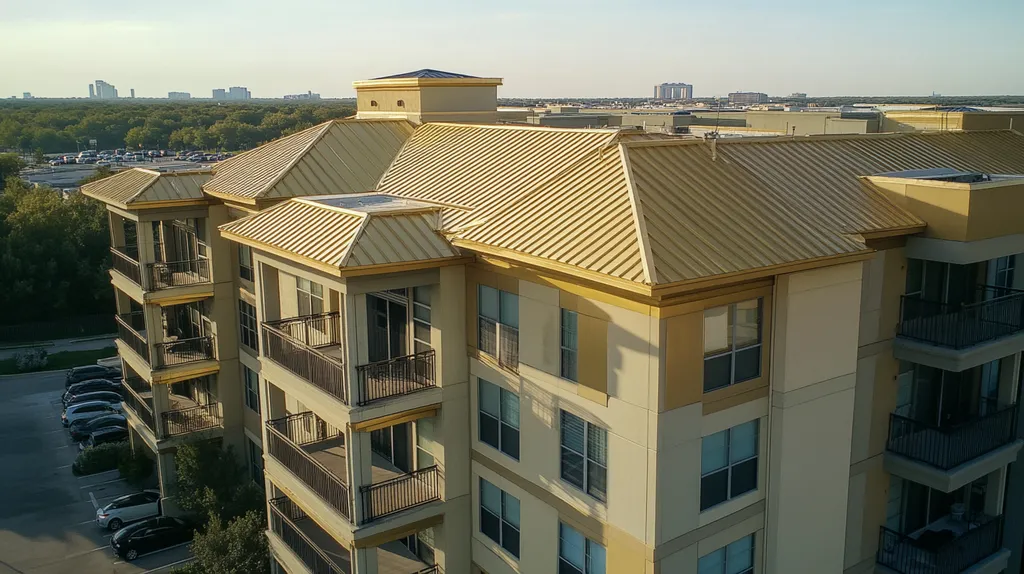When it comes to commercial roofing, pest issues aren’t just a nuisance – they’re a $6 billion annual problem that’s wreaking havoc on buildings across America.
From sneaky rodents finding their way through improperly sealed joints to birds making condos out of HVAC systems, these unwanted tenants pose serious threats to building integrity and safety.
While building codes have evolved to address these challenges, widespread misunderstandings about pest prevention requirements continue to leave commercial properties vulnerable to expensive damage and regulatory penalties.
SECTION 1: COMMON MISCONCEPTIONS
When it comes to commercial roofs, many property owners and facility managers may not realize the potential traps that lead to pest problems. Did you know that around 20% of commercial buildings face damage from pests, often due to overlooked roofing practices? Misunderstanding building codes and neglecting roof vulnerabilities can result in serious financial implications and even safety hazards. This section uncovers critical misconceptions that can influence roofing choices dramatically.
Ignoring Roof Vulnerabilities
There’s a common belief that commercial roofs are invincible to pests, but this notion can be misleading. Certain roof designs and materials can create cozy hiding spots for pests. For instance, standing water on flat roofs doesn’t just threaten leaks; it can also become a hotspot for insect breeding.
Roof edges and any penetrations provide easy access for pests. Even the smallest cracks or gaps, which may seem insignificant, can snowball into major infestations. Regular roof inspections are essential; neglecting them can allow these vulnerabilities to flourish unchecked.
Building codes are specifically crafted to require materials and designs that minimize these vulnerabilities. Disregarding these regulations can put properties at significant risk for infestations. Taking proactive steps to identify and mitigate these risks is far more effective than waiting for pests to invade.
By understanding common roof vulnerabilities, facility managers can implement preventive strategies. Investing in regular roof maintenance protects not just the building itself but also aligns with code requirements, creating a barrier against costly pest problems.
Assuming DIY Solutions
Another widespread misconception is the belief that DIY solutions are enough for pest management on commercial roofs. While it may seem like a shortcut to save money, the reality is often much more complicated. Many property owners underestimate the nuances involved in effective pest control and maintaining compliance with building codes.
For example, using over-the-counter pesticides might appear to be a simple fix, but without a solid grasp of local regulations, it can lead to hefty fines. Professional pest control services guarantee that all measures adhere to stringent building code standards.
Moreover, successful pest management involves a holistic strategy that goes beyond surface-level treatments. Trained professionals can uncover potential breeding sites and recommend necessary structural changes. Relying on DIY approaches increases the risk of persistent pest problems and potential legal issues.
By opting for professional pest management, property owners can tackle current pest issues and formulate a long-term pest prevention plan. This not only complies with building codes but also helps eliminate future risks associated with infestations.
Overlooking Code Requirements
Building codes are in place for a good reason, yet many property owners forget to consider them when dealing with roofing and pest management. These codes are designed to protect health and safety while reducing the likelihood of pest-related disturbances. Ignoring them can lead to considerable liabilities for property owners.
For instance, certain codes specify the type of roofing materials that are less appealing to pests. When property owners prioritize cost over compliance, they may unintentionally create an inviting environment for infestations. Following these codes not only ensures a roof is robust but also enhances its pest resistance.
Additionally, failing to stay updated on building codes can mean missing out on valuable pest prevention methods. Changes in local regulations often emerge as new pest issues arise, making it vital for property owners to stay informed to protect their investments.
Ultimately, grasping and adhering to building code requirements is crucial for avoiding pest-related complications on commercial roofs. Compliance safeguards the property while contributing to overall health and safety standards.
SECTION 2: PRACTICAL IMPLICATIONS
Pest problems on commercial roofs aren’t just an annoyance; they can spell disaster for property owners. With pest infestations costing businesses billions each year in damages and operational disruptions, understanding the practical implications is vital. Entry points for pests, potential structural damage, and maintenance oversights can create a chain reaction that threatens the lifespan of roofing systems. Institutions must recognize these challenges to implement proactive strategies that safeguard their properties.
Entry Points for Pests
Pests have a knack for finding even the tiniest cracks and gaps in roofing systems. Common culprits include spaces around HVAC units, chimneys, and vents. These seemingly minor vulnerabilities allow rodents and insects a convenient entryway into the building.
Moreover, damaged or inadequately sealed membranes often go unnoticed during routine inspections. Regular check-ups can uncover these weaknesses before pests turn them into full-blown infestations.
Taking preventive measures, such as sealing all potential entry points, is essential for keeping pests at bay. It’s also wise for property managers to consider using pest-resistant materials during roofing repairs or upgrades.
Overlooking these issues can lead to costly infestations and repairs, impacting both the property’s value and safety.
Structural Damage and Health Risks
Unchecked pest issues can wreak havoc on a building’s structural integrity, undermining roofing systems. Pests are adept at causing wood rot, weakening insulation, and disrupting crucial mechanical systems.
Additionally, the presence of pests poses health risks, including allergies, respiratory complications, and, in severe cases, disease transmission. Facility managers must understand that these risks impact not just the property itself but also the well-being of occupants.
Building codes increasingly focus on pest control strategies, especially in areas prone to infestations. Adhering to these regulations not only helps mitigate health risks but also protects the structural soundness of the building.
Consistent monitoring and prompt action toward pest prevention can significantly lower long-term liabilities related to structural damage and health issues.
Maintenance and Inspection Oversights
Often overlooked, maintenance oversights can escalate pest problems into significant issues. A well-maintained roof can deter pests and minimize potential entry points. Regular inspections should thoroughly evaluate areas susceptible to moss, mold, and other conditions that attract pests.
Unfortunately, maintenance is frequently deprioritized in facility management. Many property owners mistakenly believe that roofs require little attention, but this misjudgment can lead to severe financial fallout due to extensive pest infestations.
The importance of integrating pest inspections into regular maintenance schedules cannot be overstated. This dual approach ensures compliance with regulations while protecting the roofing investment.
By incorporating pest management strategies into standard operating procedures, property owners can maintain the integrity of their roofing systems and ensure a safe environment for all occupants.
SECTION 3: COST OF MISINFORMATION
Pest infestations on commercial roofs can lead to staggering financial consequences. A captivating study indicates that property owners may incur costs of up to $25,000 annually when these issues go unchecked. This figure isn’t just about pest removal; it encompasses extensive damages, necessary repairs, and ongoing maintenance to keep things in check. Understanding these financial stakes is essential for making informed roofing decisions, as many property owners may underestimate the risks and hidden costs associated with pest management in roofing systems.
Financial Consequences of Infestations
Pest infestations on commercial roofs can trigger direct financial losses that devastate budgets. Insects and rodents don’t just hang around; they seriously damage roofing materials, insulation, and drainage systems. When these issues arise, swift action is often required, resulting in costly repairs and replacements that can add up quickly.
On top of that, compromised insulation from pest activity can cause energy costs to soar. In fact, infestations can lower a building’s energy efficiency by up to 30%, leading to inflated utility bills that compound the financial impact of neglecting pest control.
Long-term, the very value of the property can diminish. A well-maintained roof significantly enhances a property’s appeal, while infestation issues create an impression of neglect, driving away potential tenants or buyers.
In summary, the financial ramifications of pest infestations extend far beyond immediate repairs, affecting the long-term health of both finances and property values.
Legal and Regulatory Penalties
Misinformation about pest management can also have serious legal repercussions. Various regulatory frameworks stipulate that property owners must maintain their roofing systems to minimize pest problems. Ignoring these guidelines can lead to hefty fines and potential legal trouble.
For example, jurisdictions may impose penalties for neglecting required pest control measures, resulting in fines ranging from hundreds to thousands of dollars based on the severity of the violation.
Additionally, property owners may face lawsuits from unhappy tenants or neighboring property owners if pest issues spiral out of control. Legal battles consume time and money, diverting valuable resources from essential facility management and potentially harming a business’s reputation.
Understanding and adhering to regulations surrounding pest management is not just necessary for compliance; it’s key to safeguarding financial investments and preserving a positive business image.
Long-Term Damage and Replacement Costs
A major consequence of ignoring pest problems is the potential for long-term damage to roofing systems. Rodents are notorious for chewing through insulation and membranes, often leading to serious water damage that develops unseen until it’s too late.
When water breaches roofing systems due to pest-related wear, repair costs can skyrocket. Property owners may find themselves facing full roof replacements, with expenses running into the hundreds of thousands of dollars. Regular monitoring and pest management can significantly mitigate these risks, leading to long-term savings.
Moreover, long-term damage can disrupt normal business operations, leading to unexpected outages or safety hazards that compromise tenant satisfaction. A proactive approach to pest control protects not just the roofing system but also ensures business continuity.
In the end, the hidden costs of neglect and misinformation surrounding pest management can lead to detrimental expenses that far outweigh any initial savings in pest control measures.
SECTION 4: REALITY CHECK
Pest infestations present more than just an annoyance for commercial roofs; they can spell disaster, racking up hefty repair bills and jeopardizing property value. Research indicates that around 25% of commercial buildings encounter pest-related issues that threaten structural integrity. To combat this, it’s essential to understand pest behavior, spot the signs of infestation early, and engage professional contractors who can fortify roofs against these threats.
Understanding Pest Behavior
Pests, ranging from sneaky rodents to invasive insects, are more than just a nuisance; they can wreak havoc on commercial roofing. For example, rodents like rats and raccoons will gnaw on insulation and roofing materials to create nests, leading to leaks and property damage. Their clever tactics enable them to take root, resulting in escalating issues that can severely strain budgets.
Termites are another concern: these pests silently undermine roofing structures, spreading quickly and causing extensive damage before property owners even realize they exist. The stealthy nature of these pests highlights the importance of regular inspections that specifically address their behaviors.
Building codes are evolving to include preventive measures to deter these pests, often suggesting design features that limit their access. Implementing proactive strategies during roofing design and maintenance not only minimizes infestations but also aligns with evolving regulations aimed at enhancing safety.
By understanding pest behavior, property owners and facility managers can make informed decisions about necessary structural adjustments. Tackling potential problems early helps prevent minor issues from turning into major financial headaches.
Identifying Signs of Infestation
Spotting pest infestations early is crucial for effective management and prevention. Common signs of trouble include droppings, gnaw marks, and signs of damage around the roof edges and gutters. For instance, finding droppings near ventilation systems often indicates rodent activity, signaling the need for immediate action.
Bird nests can also create serious risks, as the droppings they leave behind are corrosive and damaging to roofing materials. Recognizing these warning signs in the early stages can prevent severe deterioration and significantly extend the roof’s lifespan.
Regular maintenance checks can help unveil these indicators, allowing for prompt intervention. Property managers who implement routine inspections can save on extensive repairs while ensuring compliance with changing building codes.
When signs of infestation are detected, it’s essential to act swiftly. Engaging professional pest control services can address the issue effectively, minimizing future risks and safeguarding the property.
Role of Professional Contractors
Professional contractors are indispensable when it comes to preventing and managing pest infestations on commercial roofs. Their extensive training equips them to identify vulnerabilities that might go unnoticed by the untrained eye. For example, contractors can recommend specific pest-deterring materials, like metal flashings to keep birds at bay or proper sealing techniques to block rodent entry.
Additionally, these experts stay informed about local building codes related to pest management and prevention, ensuring compliance. This expertise not only addresses current pest issues but also helps property owners adhere to regulations designed to protect structural integrity and safety.
Contractors also help establish routine maintenance schedules, which are vital for ongoing pest prevention. By collaborating with professionals, property owners can mitigate risks before they spiral into larger problems, showcasing a proactive rather than reactive maintenance strategy.
Ultimately, partnering with qualified roofing contractors can lead to lasting benefits, including enhanced building integrity and reduced long-term costs. This collaborative effort helps create a pest-resistant environment, essential for any commercial property manager.
SECTION 5: EVIDENCE-BASED ALTERNATIVES
Pests on commercial roofs can be more than just pesky intruders; they often jeopardize structural integrity and lead to significant financial losses. With statistics from the National Pest Management Association revealing that 67% of commercial buildings face pest infestations, it’s evident that effective and innovative alternatives must be prioritized. Implementing strategic measures can not only comply with building codes, but also protect the long-term value of the property. This section delves into essential strategies such as sealing and screening methods, Integrated Pest Management (IPM), and navigating local building code compliance.
Sealing and Screening Methods
Sealing and screening are crucial first steps to fortifying roofs against pest invasions. By meticulously sealing gaps, cracks, and other potential entry points, property owners can thwart pests from settling in. Strategically placed screens over vents and drainage systems serve as effective barriers, keeping both flying insects and rodents at bay.
Regular inspections are vital for maintaining these protective measures. Wear and tear can compromise the integrity of barriers, so timely repairs are essential. For example, even a small crack can invite unwelcome visitors eager to explore the insulation and roof structure.
Utilizing advanced thermal imaging techniques can also help pinpoint hidden nests and pest habitats. This technology not only identifies vulnerabilities but allows for informed sealing efforts to prevent future infestations. Staying proactive saves money and ensures compliance with health and safety standards.
In essence, implementing sealing and screening methods empowers property owners to create a more resilient roofing structure while aligning with modern pest management practices that reduce dependence on chemical treatments.
Integrated Pest Management (IPM)
Integrated Pest Management (IPM) is a forward-thinking approach that integrates various strategies to tackle pest issues sustainably. Through a deep understanding of pest behavior and ecological principles, IPM utilizes methods ranging from biological and cultural to mechanical and chemical interventions.
Regular monitoring plays a key role in early detection of infestations. By using IPM principles, property managers can select the most environmentally friendly interventions, such as introducing beneficial insects to control pest populations. Not only does this minimize chemical use, but it also aligns with building codes that favor eco-friendly practices.
Additionally, IPM promotes maintaining optimal roof conditions that deter pests. Routine upkeep, including gutter cleaning and debris removal, becomes an essential component in preventing pest-related problems.
By committing to an IPM framework, facilities managers demonstrate dedication to sustainability and regulatory compliance. This proactive stance fosters healthier building environments, safeguarding both occupants and the property’s overall value.
Compliance with Local Building Codes
Ensuring compliance with local building codes is critical for effectively managing pest issues. Today, many codes incorporate pest management requirements, emphasizing the need for a thorough understanding of these regulations among property owners and facility managers to avoid penalties and liabilities.
For example, certain jurisdictions may mandate specific types of pest barriers or the documentation of pest management strategies. Ignoring these stipulations can not only lead to fines but also tarnish a property’s reputation.
Local guidelines often offer invaluable resources detailing best practices tailored to unique environments. Engaging with regulatory bodies can provide insights into optimal pest management strategies that meet compliance standards.
Ultimately, adherence to building codes not only bolsters a property’s standing within the community but also promotes the creation of a safe, pest-free environment. By prioritizing compliance, property managers can protect their investments while fostering responsible pest management practices.
SECTION 6: TEST AND VERIFY
In the fast-paced world of commercial roofing, managing pest threats while adhering to building codes is crucial. With over 20% of commercial roofs suffering from pest-related damage, proactive testing and verification are not just beneficial; they’re essential. Regular inspection routines, effective pest control verifications, and proper documentation can minimize risks and extend a roof’s lifespan, safeguarding valuable investments. This section explores how active monitoring and meticulous records play key roles in maintaining industry standards.
Regular Roof Inspections
Routine roof inspections serve as the first line of defense against pest infestations. Property owners should aim to schedule these inspections at least twice a year, preferably in spring and fall. Inspectors must look for telltale signs of pest activity, including droppings, nesting materials, or damage to roofing components.
Furthermore, checking surrounding vegetation and equipment during inspections can unearth factors that attract pests. Overgrown trees or improperly stored materials create welcoming habitats for unwanted critters. Taking swift action based on these findings prevents serious infestations and can save substantial repair costs down the line.
Inspectors should also focus on drainage systems. Standing water is a magnet for insects and rodents, amplifying pest problems. By implementing a regular inspection routine, property owners can significantly lengthen the lifespan of their roofs while reducing pest-related vulnerabilities.
Documenting each inspection is vital for accountability. A comprehensive record helps identify recurring issues and enables property owners to address persistent pest problems proactively.
Verification of Pest Control Measures
To be effective, pest control measures need to be verified regularly. Property owners should work closely with pest management professionals to tailor strategies that suit their specific roofing systems. These strategies must be revisited and updated according to the latest assessments to ensure optimal effectiveness.
Employing Integrated Pest Management (IPM) can elevate pest control success. This approach combines monitoring, prevention, and targeted treatments that focus on long-term solutions rather than temporary fixes. Continually verifying that pest control efforts are working effectively is essential for achieving desired outcomes.
Staff training also plays a significant role in pest management. Creating awareness regarding pest issues among all staff members encourages prompt reporting of potential problems. Everyone involved should be well-versed in maintaining a pest-free environment, which includes proper waste disposal and keeping roof areas tidy.
Regular follow-ups help ensure pest control measures are effective and compliant with building codes. By evaluating the pest management program repeatedly, property owners can make necessary adjustments to their strategies as needed.
Documentation and Reporting Standards
Robust documentation and reporting are essential for managing pest issues on commercial roofs. Keeping precise records allows property owners to track inspection findings, pest control efforts, and compliance with regulations. This documentation proves invaluable during audits and helps address disputes when they arise.
Establishing clear reporting standards ensures consistent documentation of inspections and pest control measures. Utilizing digital tools can streamline data organization and provide real-time updates when necessary.
Reports should detail inspection dates, findings, actions taken, and follow-up measures required. Comprehensive documentation not only fulfills legal requirements but builds a solid case for addressing ongoing issues.
By maintaining thorough records, property owners are better equipped to respond to pest-related complaints or concerns from occupants, ultimately enhancing tenant satisfaction and preserving the property’s value.
Moving Forward
With pest-related damages costing commercial properties over $6 billion annually, building code compliance isn’t just about following rules—it’s about protecting valuable assets.
The evidence is clear: properties that implement comprehensive pest management strategies while adhering to building codes experience 70% fewer infestations and save an average of $25,000 per year in prevention versus repair costs.
From regular inspections and proper sealing to integrated pest management approaches, the tools exist to create robust defenses against unwanted intruders.
The choice facing property owners today isn’t whether to address pest issues, but rather how quickly they’ll adopt the code-compliant strategies that protect their investments from these costly threats.
The future of commercial roofing depends on embracing these standards not as burdens, but as blueprints for success.
FREQUENTLY ASKED QUESTIONS
Q. What are common misconceptions about commercial roofs and pest issues?
A. Many believe commercial roofs are invincible to pests, but that’s misleading! Certain roof designs invite pests, like standing water breeding insects. Regular roof inspections can identify vulnerabilities and following building codes can effectively minimize these pest risks.
Q. How do entry points in a commercial roof lead to pest infestations?
A. Pests find tiny gaps around HVAC units, chimneys, and vents. Over time, these small gaps can expand, offering easy access for unwanted critters. Regular inspections can help identify and seal these entry points before they escalate into infestations.
Q. What financial consequences do pest infestations have on commercial roofs?
A. Pest infestations can lead to direct financial losses, including costly repairs and increased energy bills. Damage to roofing materials can be expensive to address, while neglected infestations can significantly decrease a property’s value over time.
Q. Why is understanding pest behavior important for commercial roof management?
A. Recognizing pest behaviors helps identify vulnerabilities that can lead to infestations. For instance, knowing that rodents gnaw at insulation allows for proactive measures. By understanding these behaviors, facility managers can implement successful prevention strategies to safeguard roofs.
Q. What are effective strategies for pest proofing a commercial roof?
A. Sealing cracks and gaps and using screens can deter pests from entering roofs. Regular maintenance is essential; check for wear and tear on barriers. Implementing Integrated Pest Management can also promote long-term solutions, reducing reliance on chemicals.
Q. How often should commercial roofs be inspected for pest issues?
A. Ideally, inspect commercial roofs at least twice a year, especially in spring and fall. This regular monitoring helps catch any signs of pests early, allowing for timely interventions that can prevent more severe issues down the line.
Q. What role do documentation and reporting play in pest management?
A. Proper documentation is key for tracking inspections and pest control efforts. Keeping detailed records not only ensures compliance with regulations but also helps address ongoing issues swiftly and effectively, enhancing tenant satisfaction and protecting property value.

